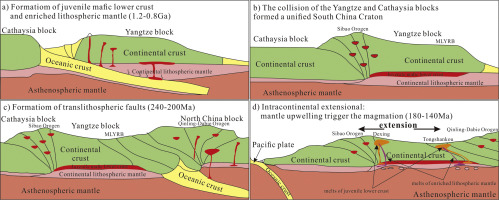当前位置:
X-MOL 学术
›
Gondwana Res.
›
论文详情
Our official English website, www.x-mol.net, welcomes your
feedback! (Note: you will need to create a separate account there.)
Early Cretaceous mantle upwelling and melting of juvenile lower crust in the Middle-Lower Yangtze River Metallogenic Belt: Example from Tongshankou Cu-(Mo W) ore deposit
Gondwana Research ( IF 7.2 ) Pub Date : 2020-07-01 , DOI: 10.1016/j.gr.2020.02.004 Gaobin Chu , Huayong Chen , Trevor.J. Falloon , Jinsheng Han , Shitao Zhang , Jiamin Cheng , Xiaobo Zhang
Gondwana Research ( IF 7.2 ) Pub Date : 2020-07-01 , DOI: 10.1016/j.gr.2020.02.004 Gaobin Chu , Huayong Chen , Trevor.J. Falloon , Jinsheng Han , Shitao Zhang , Jiamin Cheng , Xiaobo Zhang

|
Abstract The linkage between intracontinental extension and the Early Cretaceous Cu-Mo-W polymetallic metallogenesis in the Middle-Lower Yangtze River Belt (MLYRB) has long been a subject of controversy due to the lack of convincing petrogenetic evidence to identify the nature of magmatic sources and their geological histories during extensional mantle upwelling. Here we present new zircon U Pb ages, isotopic and geochemical data for granodiorites, quartz diorites and mafic microgranular enclaves (MMEs) in the Tongshankou area. Comparing the MMEs with their host porphyries, the different ratios of incompatible elements and the similar formation ages, coupled with quenched margins and the xenocrysts in the MMEs, indicate that the MMEs was most likely formed by mixing between mafic magma and their host felsic magma. The MMEs share similar geochemical and isotopic characteristics with the Cretaceous mafic rocks from MLYRB, indicating that MMEs were mostly derived from an enriched lithospheric mantle source without adakitic characteristics. Mixing of a crustal melt derived by melting of an amphibolite bearing juvenile lower crust with a mantle melt derived from melting of enriched lithospheric mantle can account for the generation of the Tongshankou prophyries. The melting of juvenile mafic lower crust and enriched lithospheric mantle is suggested to be caused by upwelling of asthenospheric mantle and the reactivity of trans-lithospheric faults in the intracontinental extensional environment. Our results therefore highlight that juvenile mafic lower crust beneath the Yangtze plate is one of the likely source for ore-forming magmatic rocks in the Early Cretaceous.
中文翻译:

长江中下游成矿带早白垩世地幔上涌与幼年下地壳熔融——以铜山口铜(钼钨)矿床为例
摘要 由于缺乏令人信服的岩石成因证据来确定岩浆源的性质,陆内伸展与长江中下游带(MLYRB)早白垩世铜钼钨多金属成矿作用之间的联系长期以来一直存在争议。及其在伸展地幔上涌过程中的地质历史。在这里,我们展示了铜山口地区花岗闪长岩、石英闪长岩和镁铁质微粒包体 (MME) 的新锆石 U Pb 年龄、同位素和地球化学数据。将 MMEs 与其宿主斑岩进行比较,不相容元素的不同比例和相似的形成年龄,加上 MMEs 中的淬火边缘和异晶,表明 MMEs 最有可能是由基性岩浆与其寄主长英质岩浆混合形成的。MMEs 与来自 MLYRB 的白垩纪基性岩具有相似的地球化学和同位素特征,表明 MMEs 主要来自富集的岩石圈地幔源,没有埃达克岩特征。含角闪岩的幼年下地壳熔融产生的地壳熔体与富集岩石圈地幔熔融产生的地幔熔体的混合可以解释铜山口岩的形成。新生基性下地壳和富集岩石圈地幔的熔融被认为是由软流圈地幔上涌和跨岩石圈断层在陆内伸展环境中的反应性引起的。
更新日期:2020-07-01
中文翻译:

长江中下游成矿带早白垩世地幔上涌与幼年下地壳熔融——以铜山口铜(钼钨)矿床为例
摘要 由于缺乏令人信服的岩石成因证据来确定岩浆源的性质,陆内伸展与长江中下游带(MLYRB)早白垩世铜钼钨多金属成矿作用之间的联系长期以来一直存在争议。及其在伸展地幔上涌过程中的地质历史。在这里,我们展示了铜山口地区花岗闪长岩、石英闪长岩和镁铁质微粒包体 (MME) 的新锆石 U Pb 年龄、同位素和地球化学数据。将 MMEs 与其宿主斑岩进行比较,不相容元素的不同比例和相似的形成年龄,加上 MMEs 中的淬火边缘和异晶,表明 MMEs 最有可能是由基性岩浆与其寄主长英质岩浆混合形成的。MMEs 与来自 MLYRB 的白垩纪基性岩具有相似的地球化学和同位素特征,表明 MMEs 主要来自富集的岩石圈地幔源,没有埃达克岩特征。含角闪岩的幼年下地壳熔融产生的地壳熔体与富集岩石圈地幔熔融产生的地幔熔体的混合可以解释铜山口岩的形成。新生基性下地壳和富集岩石圈地幔的熔融被认为是由软流圈地幔上涌和跨岩石圈断层在陆内伸展环境中的反应性引起的。











































 京公网安备 11010802027423号
京公网安备 11010802027423号